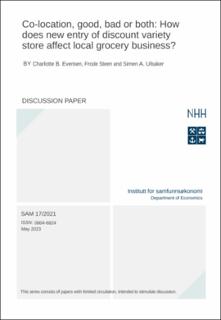| dc.contributor.author | Evensen, Charlotte B. | |
| dc.contributor.author | Steen, Frode | |
| dc.contributor.author | Ulsaker, Simen A. | |
| dc.date.accessioned | 2021-09-08T09:31:21Z | |
| dc.date.available | 2021-09-08T09:31:21Z | |
| dc.date.issued | 2021 | |
| dc.identifier.uri | https://hdl.handle.net/11250/2774572 | |
| dc.description.abstract | We analyze 69 entries and relocations by the Norwegian discount variety chain Europris during the period 2016 to 2019. We measure how its location choices affect local grocery stores’ performance, using a diff-in-diff strategy and data from a large Norwegian grocery chain. We combine detailed data on local grocery stores’ sales, traffic and travelling distance to new or relocated Europris stores. We find that entries and relocations have significant effects, suggesting an S-shaped relationship; sufficiently close entries increase local demand since more customers are attracted to the market, but, as the distance increases, the competitive effect of a new discount variety store dominates, and local grocery sales and traffic are reduced. As we move further away, the entry effect is gradually reduced to zero. We show that this empirical finding can be squared with a simple theoretical model. Our results confirm theoretical conjectures on agglomeration forces and competitive effects from local competition. | en_US |
| dc.language.iso | eng | en_US |
| dc.relation.ispartofseries | SAM DP;17/2021 | |
| dc.subject | Retail economics, local competition effects, positive agglomeration forces, grocery markets | en_US |
| dc.title | Co-location, good, bad or both: How does new entry of discount variety store affect local grocery business? | en_US |
| dc.type | Working paper | en_US |
| dc.source.pagenumber | 42 | en_US |
